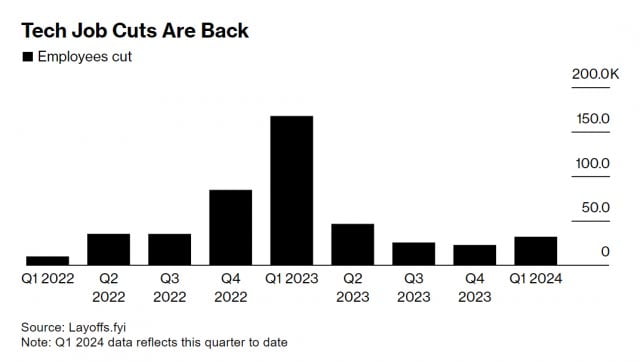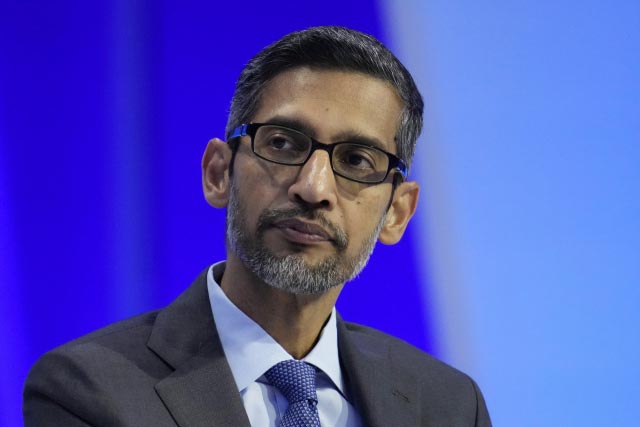Silicon Valley Blows Cold Winds Despite Favorable Us Employment Why Layoffs Continue
The layoff storm in Silicon Valley continued for two years, and there are concerns that layoffs will follow the change in success formula as the leader of Big Tech, which chooses efficiency over growth.
According to the January employment indicator released on the 2nd (local time), the United States surprised the market by adding 353,000 new jobs. Not only did it show the largest increase in a year, it also beat experts’ forecasts of 185,000. Compared to , recovery was twice as high. There are high expectations that the frozen job market is thawing, but there is one area where cold winds still blow: Silicon Valley. Here, the ‘layoff storm’ that began in 2022 has continued for more than two years.
In fact, Silicon Valley tech companies, which had laid off 260,000 technical workers by the end of last year, cleared the desks of about 33,000 employees in the first month of the year alone. Why have technical experts in the tech industry, who were envied by everyone with high salaries, generous welfare benefits, and promising careers, suddenly lost their place?
Failure Of Optimism… A Reaction To Excessive Weight Gain.
Excessive optimism about growth has led to overemployment. “As a founder and CEO, I feel responsible for leading the company in the wrong direction.”
Mark Zuckerberg said this at Meta’s executive meeting held on November 8, 2022. And the next day, on the 9th, large-scale layoffs were carried out on about 11,000 people, equivalent to 13% of the employees. It was the first large-scale restructuring in 18 years since Meta was founded in 2004, and it was a signal for a storm of layoffs in Silicon Valley that will continue in the future.

Zuckerberg’s reflection can be seen as representative of the feelings of many Silicon Valley tech executives. During the coronavirus pandemic, demand for untact (non-face-to-face) services surged, and tech companies rushed to expand their presence with optimism about a rosy future. At that time, central banks around the world, concerned about an economic recession, lowered interest rates to zero, and lost funds poured into Silicon Valley. Technology companies put a lot of effort into attracting human resources, even paying them extra money. More than 900,000 new jobs were created at major big tech companies such as Amazon and Alphabet alone.
But the pandemic is over and people have returned to their places. There has also been a realization that the realization of complete untact, metaverse, and extended reality ( XR ) is still a distant future. Investment in technology has decreased, purchases of cloud services and software have declined, and the profitability of big tech has worsened.
Companies where survival became more important than growth began to reorganize. At the same time as reducing the excessive size, we scaled back the ‘promising future’ businesses that had been established. Zoom , a non-face-to-face service that grew rapidly during the pandemic, laid off about 150 people again on the 1st, a year after laying off about 1,300 people, equivalent to 15% of the total staff, in February 2023.
Amazon laid off hundreds of people in its streaming business and pharmacy division, which it had invested heavily in during the pandemic. Subsidiary Twitch also recently laid off 500 people, and CEO Dan Clancy explained the reason for the restructuring by saying, “The size of the company is bigger than the size of the business.”
Stock Prices Plunged Due To High-Interest Rates, Intense Pressure For ‘Improvement’ From Investors.
No matter how much profitability has deteriorated, the firestorm of layoffs at tech companies that has continued for more than two years still seems excessive. The Washington Post believes that this is because tech companies are under pressure from investors to further improve profitability. As the company has already grown in size, it is difficult to show the same growth as in the past, and in a situation where even investors have begun to turn their backs on tech companies, tech company executives had to make bold decisions to show that ‘we have changed.’ The result is a cost-saving effort through surprisingly bold workforce reductions.
Until now, the growth of technology companies has largely depended on investment (borrowing) from venture capitalists and funding through stocks. While the U.S. base interest rate rose rapidly from 0-0.25% in January 2022 to 5.25-5.5% over 1 year and 6 months, the stock prices of U.S. technology stocks, classified as so-called ‘high PER (price-to-earnings ratio) stocks’, took a big hit.
Wore it In a high interest rate environment, which is at the highest level in 20 years, the future profits of technology companies were greatly discounted and the investment value also plummeted. In fact, in 2022, Nasdaq fell vertically by about 36% from 15,800 to 10,888, and a number of companies saw their stock prices fall by half compared to the high point.
And the strategy was very successful. Meta’s performance for the fourth quarter of last year, announced on the 2nd, was the best among S&P 500 companies, and on this day, Meta’s stock price soared 20.32%, breaking an all-time high. Amazon also submitted an excellent report card for the fourth quarter of last year thanks to its strategy of mass laying off about 35,000 people by 2023, and its stock price also continued to rise, on the verge of breaking its previous high. Bloomberg News analyzed Meta and Amazon, saying, “They have proven that their austerity strategy over the past 16 months was reasonable.”

The Rise Of AI And A Different Future
Another cause is the rise of artificial intelligence (AI). While concerns about future jobs are growing due to the advancement of AI, it is perhaps ironic that the first to be hit are technology companies that have focused on AI development. Technology company executives with a high understanding of the potential of AI are looking to the future faster and further ahead and are reducing manpower and freezing hiring. Datamine, a New York-based big data startup valued at $4.1 billion, laid off 150 people, or about 20% of its employees, at the end of November last year, citing “rapid development of AI platforms” as the reason.
Sebastian Simiatkowski, co-founder and CEO of Klarna, a Swedish fintech company leading the global postpaid payment ( BNPL ) market, also said in an interview with The Telegraph in December last year that hiring would be frozen for the time being. He said, “ By using AI technology, tasks that previously took a lot of time can be done much more quickly and simply, and fewer people are needed to do the same work. “We will wait and see the situation rather than hiring right away.”

AI becoming a priority is also a factor encouraging workforce realignment through restructuring. Big techs are spending billions of dollars investing in AI instead of hiring thousands of people every quarter. WSJ said, “ Companies that develop their own AI can create room for more investment (through job cuts).” In fact, Zuckerberg said in a conference call, “We need to lay off employees and control costs in order to invest in a long-term and ambitious vision for AI.” Sundar Pichai, CEO of Google, also emphasized in an internal notice last month, “The reality is that we have to make difficult choices (reduction of employees) in order to create capabilities to invest in priorities (AI).”
‘Efficiency’ Replaced Growth… Nasdaq’s New Success Formula
Even at the beginning of the mass layoffs in Silicon Valley, the industry’s outlook was optimistic. Due to the nature of a growing industry with many ups and downs, there was an expectation that the company would improve its finances through bold restructuring and accelerate growth and increase employment despite the favorable financial environment. However, as the wave of layoffs continues for more than two years, optimism is gradually giving way to pessimism. In particular, in a situation where big tech companies are calling for ‘efficiency’ rather than growth and investors are also accepting restructuring as good news rather than bad news, it is interpreted that restructuring in Silicon Valley may continue for some time.
In fact, Amazon Chief Financial Officer (CFO) Brian Olbrasky said in a recent conference call, “We will continue to be cautious about where we invest, and if we can do more with less, we will do so.” Google also warned employees that layoffs could continue throughout the year, and Meta CEO Mark Zuckerberg also said, “We have seen that we can run better as a leaner company.”
The fact that technology company executives have no reason to hesitate about layoffs also raises concerns that the storm of layoffs will continue. In the past, companies tended to avoid mass layoffs for fear that restructuring would be perceived as a bad signal. However, with more than 1,200 companies in Silicon Valley carrying out layoffs, even executives at companies with modest profits are considering ways to do more work with fewer workers. In addition, the restructuring of technology companies appears to be well received as a ‘good decision’ on Wall Street. In fact, Nasdaq, which lost a third of its market capitalization in 2022, rose 43% in 2023.
See More:
US and US leaders join forces to support Ukraine
Why Are Chinese Women Crazy About Taylor Swift?
Swift Effect, Boyfriend’s NFL Viewer Ratings Explode “Revenue Of 440 Billion Won”
Elon Musk: I Will Soon Remove My Phone Number Call And Text Only With X




Leave a Comment